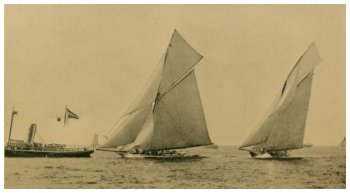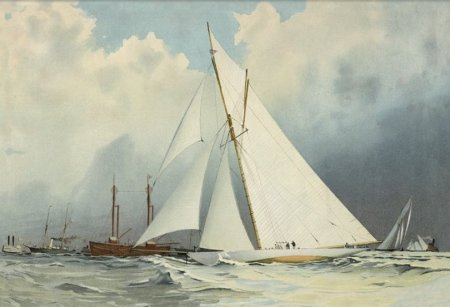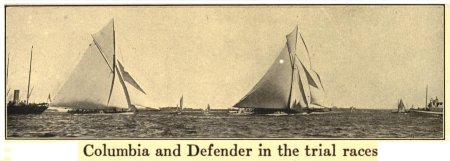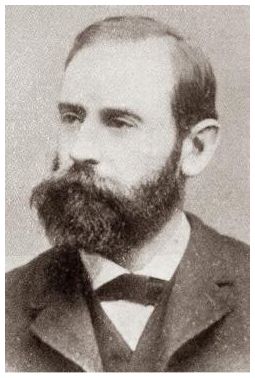Yves GARY Hits: 4287
Category: DEFENDER
 1895 America's Cup defender
1895 America's Cup defenderDefender was designed by Nathanael Greene Herreshoff and built by the Herreshoff Manufacturing Company in 1895. It was Herreshoff's second victorious America's Cup defender design. She was a sloop with all-metal construction: steel, aluminum, and manganese bronze.
Defender was owned by William Kissam Vanderbilt, Edwin Dennison Morgan and Charles Oliver Iselin, and skippered by Henry C. Haff.
Between July 20 and August 8 , Defender participates in a series of regattas especially against Vigilant which has been prepared for the occasion.
From August 20 to 30, Defender defeated the New York Yacht Club's Vigilant in the trial races for defend the Cup against British keel cutter Valkyrie III.

 - from 7 to 12 September 1895, at New York.
- from 7 to 12 September 1895, at New York.
- the contest was to be decided by the winning three races out of five.
- the first, third and fifth races to be to windward and leeward, the second and fourth over a triangle, all courses to be thirty miles, and laid to windward when possible.
- the starts to be from Sandy Hook light-vessel.
- starting signals to be given at 11 o'clock, and delayed only in event of changing the starting-point, fog, or agreed postponement; preparatory gun to be fired ten minutes before starting signal, and handicap gun two minutes after
- time limit for races six hours.
- all length over eighty-nine feet load water-line to count double in figuring racing length for time allowance.
- vessels to be allowed time for repairs in case of an accident.
- yachts to be measured with all weights on board to be carried in a race, restrictions as to bulkheads, floors, doors, water-tanks and anchor being waived.
Defender is confronted Valkyrie III, the challenger of Royal Yacht Squadron.
Three regattas are "raced". Defender beat Valkyrie III, three wins to nil.
- September 7, 1st race, 30 miles, windward-leeward : Defender beat Valkyrie III by 8 mn 49 s corrected time. Claim of Lord Dunraven for modification of the waterline length of Defender. Claim rejected : Defender 1 - Valkyrie 0.
- September 10, 2nd race, 30 miles, triangle : Valkyrie IIIbeat Defender by 47 s corrected time. Claim of Charles Oliver Iselin for denial of priority. Claim accepted : Defender 2 - Valkyrie 0.
- September 12, 3rd race, 30 miles, windward-leeward : Valkyrie III cuts the starting line and leaves. Defender 3 - Valkyrie 0.
A challenge to forget, a real fiasco.

 Following the contest, Defender was towed to New Rochelle where it remained for another four years without sailing.
Following the contest, Defender was towed to New Rochelle where it remained for another four years without sailing.
On 1899, it was rebuilt to race trials against the America's Cup defense candidate, Columbia.
After the trial races in 1899, DEFENDER went into the junk dealer's hands. Thomas W. Lawson put in a tentative bid of several thousand dollars for DEFENDER in the spring of 1901. He needed her as a trial boat for his INDEPENDENCE. DEFENDER was too corroded and W. Butler Duncan took her from New London to City Island where she was broken up.
 Juin 1901: Defender was broken up in 1901.
Juin 1901: Defender was broken up in 1901.

 The fall of 1894, a challenge for the America's Cup was received from Lord Dunraven and I was looked to [for the] design [of] another defender. ... The next craft, which was finally named DEFENDER, was owned by a syndicate headed by C. Oliver Iselin, and he took Hank Haff as skipper. The yacht had many novel features that we put on her. I insisted that she be fitted with a deep draft keel, instead of a centerboard, and [this was] very much to the opposition of all our American yachtsmen. She was the first to be framed with bulb angles, without reverse angles, and we had to pay for the mill-rolls to make them, as the sizes we needed were not in existence. We induced the rolling mill to roll the deck beam bulbs of aluminum and they made a good job of it.
The fall of 1894, a challenge for the America's Cup was received from Lord Dunraven and I was looked to [for the] design [of] another defender. ... The next craft, which was finally named DEFENDER, was owned by a syndicate headed by C. Oliver Iselin, and he took Hank Haff as skipper. The yacht had many novel features that we put on her. I insisted that she be fitted with a deep draft keel, instead of a centerboard, and [this was] very much to the opposition of all our American yachtsmen. She was the first to be framed with bulb angles, without reverse angles, and we had to pay for the mill-rolls to make them, as the sizes we needed were not in existence. We induced the rolling mill to roll the deck beam bulbs of aluminum and they made a good job of it.
The yacht was plated with Tobin bronze on the bottom and aluminum on [the] topsides and deck. She was fitted with galvanized steel wire cables, instead of chains, and had a special very light capstan, instead of [a] windlass. We were convinced cross-cut sails were best, and when asking Wilson and Silsby to make them, they absolutely refused that way, and so did [the] other makers. We, therefore, had to fit up a larger sail loft in the attic of the North Construction Shop, and we hired the Infantry Hall in Providence for laying down and cutting the canvas, which we had specially woven by the Lawrence Manufacturing Company. The sails turned out very satisfactory.
It is interesting that Mr. Iselin was very skeptical about our ability to make good sails, so he got a set of drawings from us and had Wilson and Silsby make a suit on his own hook. I never saw them, but they were bent on when the yacht was up Sound and tried only one day, then our sails put back. This was the beginning of the cross-cut sail era, and now they are made that way all over the world.
DEFENDER'S original mast was of light wood and weak and had to be replaced. (A piece cut off upper end of the timber is still in our playroom) [This piece is now on exhibit at the Herreshoff Marine Museum] The second mast was much heavier and Mr. Iselin gave us an order for making a steel mast. This was lighter and [more] satisfactory and was used in the trial and Cup races. This was the first steel mast in racing yachts.
DEFENDER never had a good chance to show her ability with Haff as skipper, but she got chosen against VIGILANT for defending the Cup. She was easily faster than VALKYRIE III, Watson's latest design. The series of races was spoiled by Lord Dunraven's singular doings [Complaints, protests, and official investigation].
After the races, Mr. Iselin moored DEFENDER in a deep creek only a mile away from his home, using her wire rope cables. It was only a short period before DEFENDER was found adrift, for electrolysis between the bronze hull and steel cables had eaten them up. DEFENDER lay in this creek for three years, [un]til after Lipton had sent another challenge for [the] America's Cup. Mr. Iselin got her out to be fitted for a trial vessel against a new defender and sailed her to Bristol under trysail. We, in the meantime, had built a new marine railway and hauling gear into our South Shop. We found much to do to her, for the aluminum, in parts, was in bad condition.
....
After the trial races [in 1899], DEFENDER went into the junk dealer's hands [In "The Fate of the Cup Defenders", Yachting, March, 1936, William Upham Swan notes that Thomas W. Lawson put in a tentative bid of several thousand dollars for DEFENDER in the spring of 1901. He needed her as a trial boat for his INDEPENDENCE. DEFENDER was too corroded and W. Butler Duncan took her from New London to City Island where she was broken up]. She had well performed her mission and that was all she was constructed for, and, from the start, durability was put aside."
(Source: Herreshoff, N. G. "Some of the Boats I Have Sailed In." Written 1934. In: Pinheiro, Carlton J. (ed.). Recollections and Other Writings by Nathanael G. Herreshoff. Bristol, 1998, p. 62-65.)
